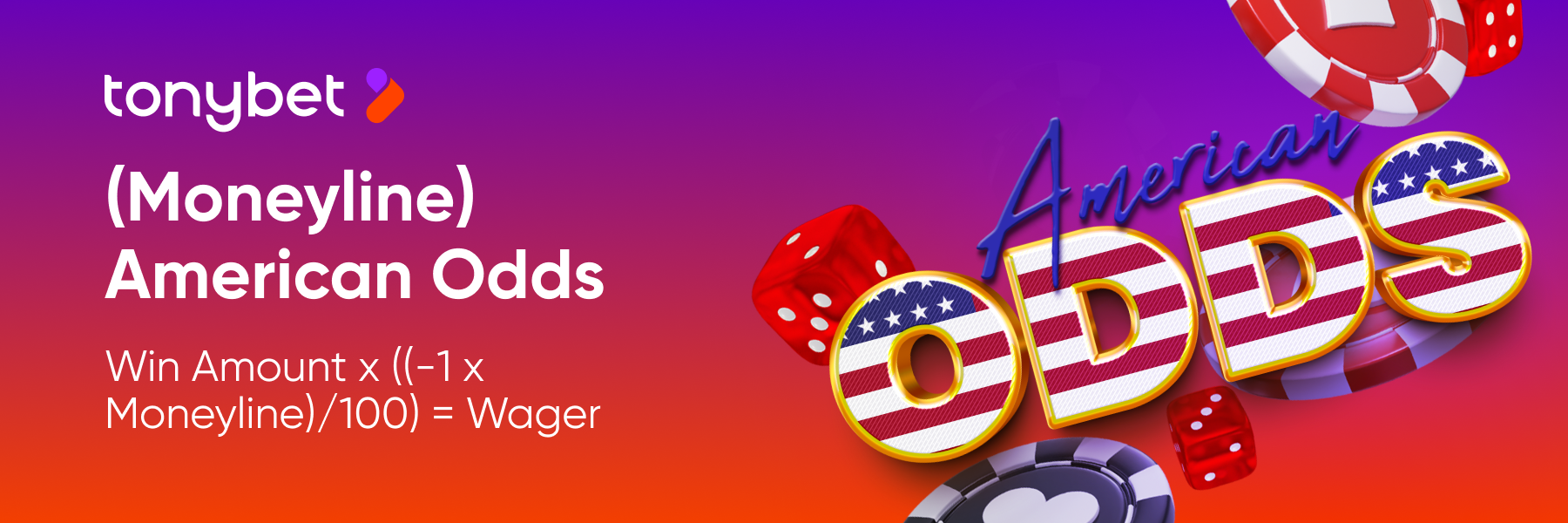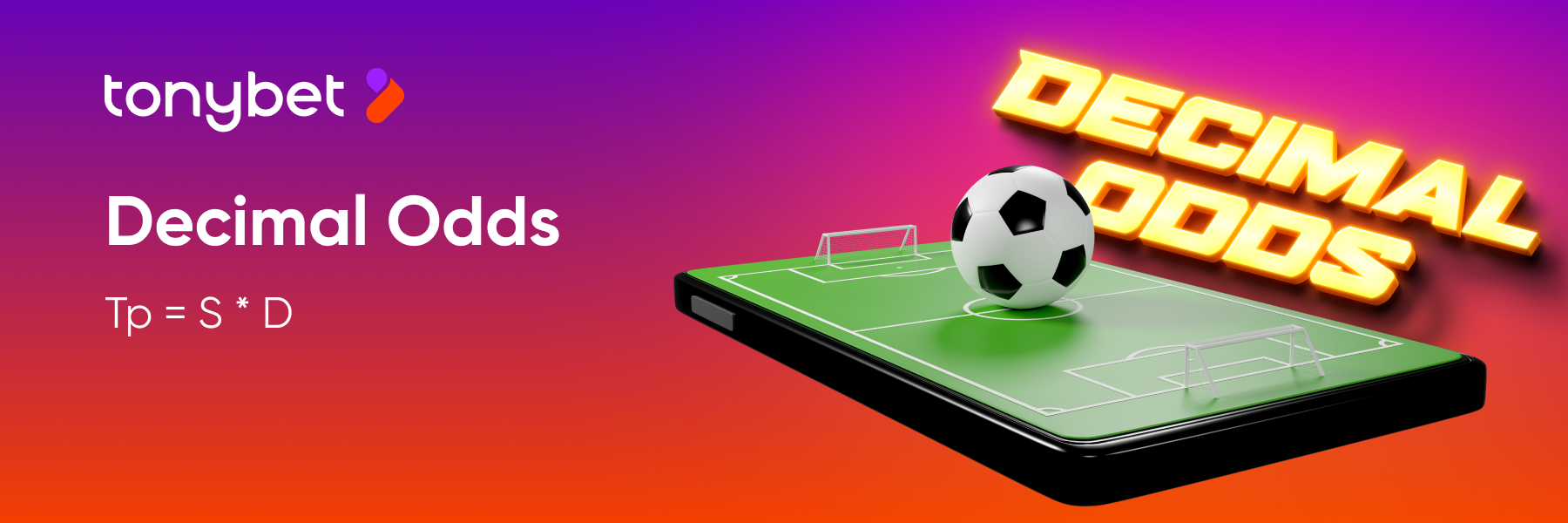Understanding odds and their essence is vital for bettors. It helps to better understand the concept of betting and place wagers more carefully. In this article, we will cover all the necessary information you need to have a grasp of the odds and place the bet at TonyBet.
Basics of Sports Betting Odds
Sports betting odds represent the probability of a particular outcome occurring in an event. These odds indicate potential payouts. A favourite has shorter odds, implying a higher likelihood of winning, while an underdog has longer odds. Bettors analyze these odds to probability to determine the expected value of their wagers and make informed decisions.
Odds Definition – What Do They Represent?
To put it simply, odds quantify the likelihood of a particular match. In betting, they indicate the potential payout on a wager. Expressed in formats like fractional, decimal, or moneyline, odds allow individuals to assess risk and reward.
How Do Odds Reflect Probability and Payout?
Odds generally convey two key concepts:
the probability of an event occurring and the potential payout from a successful bet. Higher odds suggest a lower event probability but promise greater returns if successful. On the other hand, lower odds indicate a higher likelihood of the event, alas, smaller payouts for a winning bet.
Read More:
Mastering The Art Of Against The Spread (ATS) Betting
A Comprehensive Guide To A Winning Sports Betting Strategy
Understanding Sports Betting Odds: A Complete Guide
Global Sports Betting: Legal Trends And Market Insights
Different Types of Odds Formats
In betting, you will encounter these three main types of odds formats:
- American Format
- Decimal Format
- Fractional Format
We will cover each of these betting basics separately.
Moneyline/American Odds

This picture presents the formula for calculating the wager needed to win a certain amount when betting using American odds, also known as Moneyline odds. The formula is displayed in a clear, mathematical format: “Win Amount x ((-1 x Moneyline)/100) = Wager.” The formula is used when the Moneyline odds are negative, indicating how much one must bet to win $100. The “Win Amount” is the desired profit, the “Moneyline” is the betting odds assigned to the team or player, and “Wager” is the amount of money one needs to bet to achieve the Win Amount. The image likely serves as an educational tool for bettors who are learning how to calculate bets based on American odds.
Calculation:
Win Amount x ((-1 x Moneyline)/100) = Wager Moneyline, or American odds, are represented by positive and negative values.
- Positive money line odds (e.g., +200) denote the profit on a $100 bet. So, a $100 wager pays a $200 profit.
- Negative money line odds (e.g., -150) show how much you must bet to earn $100. In this case, a $150 bet secures a $100 profit. This is how the odds calculator works.
Decimal Odds

This image shows the formula to calculate the total payout (“Tp”) when betting with decimal odds. The formula is succinctly put as “Tp = S * D,” where “Tp” stands for the total payout, “S” is the stake or the amount of money wagered, and “D” represents the decimal odds offered on a bet. This type of odds is straightforward and popular in many betting markets outside North America. The picture seems to be a simple visual aid to help bettors understand how their total payout is computed when they place a bet using decimal odds.
Calculation:
Tp = S * D
Decimal odds represent the total return on a successful bet, inclusive of the original stake. For instance, odds of 2.00 mean a $10 bet yields $20 in total ($10 stake + $10 win). For odds calculation, simdecimal oddsply multiply the stake by the . So, a $50 bet at 1.75 odds would return $87.50 ($37.50 profit plus the $50 stake).
Fractional Odds

The picture contains the formula for calculating the total payout when using fractional odds. It is depicted as “Tp = (S * (N / D)) + S”. Here, “Tp” is the total payout, “S” is the stake, “N” is the numerator (or the first number in the fraction), and “D” is the denominator (or the second number in the fraction). Fractional odds are commonly used in the UK and Ireland. They represent the profit (N/D) for every unit of stake. The formula shows how to calculate the total payout, which includes the profit plus the original stake. The image likely functions as an instructional piece to assist bettors in understanding how winnings are computed using fractional odds.
Calculation:
Tp = ( S ( N / D ) ) + S
Fractional odds, often seen as 5/1 or 2/3, depict potential profit relative to a stake. For instance, 5/1 means for every $1 bet, the profit is $5. To convert to percentagea , take the fraction’s denominator and divide by the sum of both numbers. For 5/1 odds, it’s 1/(5+1) = 1/6 or approximately 16.67% probability.
Read More:
Addressing Addictive Betting: Strategies For Recognition And Management On Tonybet
Guarding Against Betting Scams: A Tonybet Guide
The Future Of AI And Machine Learning In Predicting Outcomes
The Pivotal Role Of Technology In The Evolution Of Online Betting
Betting Odds Explained
While betting, you will encounter a lot of types of odds. Mainly you can wager funds on:
- Over/Under
- Point Spread
- Prop Bets
Over/Under Betting
Over/under betting involves wagering on whether a specific match’s outcome will surpass (over) or fall short (under) of a predetermined number set by bookmakers.
Common in sports, bettors might bet on the combined score of two teams, guessing if it’ll be over or under the bookie’s set total.
For example, in the match between Canada and Brazil, you might bet on over 2.5 goals, and the match must at least have 3 goals.
Point Spread Betting
Point spread betting balances the playing field between underdogs and favourites. Bookmakers assign a margin of points that the favourite should win by. Bettors then wager on the favourite to win by more than the spread or the underdog to lose by less than or win outright. For instance, if you bet 0:1 on Vancouver Canucks against Nashville Predators, the former must win by at least 2 points.
Prop Bets and Their Odds
Prop bets, or proposition bets, focus on specific events within a match rather than the outcome. Examples include betting on a player’s total points or if a team scores first. You might place a bet on Shai Gilgeous-Alexander’s individual stats. The odds for prop bets vary based on the event’s perceived likelihood and can offer diverse wagering opportunities.
Parlay Bets
Parlay bets combine multiple wagers into one bet. To settle the bet successfully, all individual bets within the parlay must win. For instance, in soccer odds, you might pick several selections. While riskier, the potential payouts are significantly higher than single bets. The more selections in a parlay, the greater the potential payout.
Factors That Influence Odds
Odds are determined by a specific number of factors. Here are the main ones that influence them:
- Team/player stats.
- Injuries.
- Public perception.
Team/Player Performance and Statistics
Team/player performance and statistics are pivotal in determining betting odds. Bookmakers analyze factors like past results, player form, injuries, and head-to-head records. For instance, if Real Madrid have been winning a lot of matches consecutively, the odds will be lower.
High-performing teams or players decrease odds due to increased winning likelihood, while underperformers increase them. Updated in real-time, these statistics ensure odds reflect the most accurate representation of an event’s potential result. In-game betting allows bettors to place wagers as the event unfolds, adding an extra layer of excitement and strategy to the experience.
Injuries and Other External Factors
Injuries and external factors significantly influence betting odds. An injured key player can weaken a team’s chances. Similarly, factors like weather conditions, team morale, or coaching changes can impact performance.
Let’s pick an example from the NHL.
If Connor McDavid is injured, the Edmonton Oilers will have lower odds compared to their opponents.
Public Perception and Betting Trends
Public perception and betting trends play a vital role in forming odds. If a majority of bettors favour one outcome, bookmakers may adjust the odds to balance their liability. Popular teams or players often have lower odds not just due to performance but also public bias.
Read More:
Advanced Sports Betting Models Explained
Navigating The Exciting Arena Of ESports Betting On Tonybet
Exploring The Excitement: The Psychology Of Betting On Tonybet
Understanding Problem Gambling: A Comprehensive Guide On Tonybet
How Bookmakers Set Odds
Bookmakers set odds by analyzing various factors: team/player statistics, past performances, injuries, and external variables like weather. They also consider public betting trends and their own margin to ensure profitability.
Using complex algorithms and expert opinions, they determine the likelihood of each outcome. Odds are then adjusted in real-time based on market dynamics and incoming bets to manage potential payouts.
Role of Bookmakers in Sports Betting
Bookmakers are central to sports betting, facilitating wagers on various events. They set odds reflecting the probability of outcomes, balancing potential payouts with their own margin. Their expertise ensures competitive, fair betting opportunities for punters.
The Concept of the “Vig” or “Juice”
The “Vig” or “Juice” refers to the commission that bookmakers take from bets. It’s their built-in advantage, ensuring they turn a profit regardless of an event’s outcome. For instance, instead of offering even odds on a coin flip, a bookmaker might offer odds slightly below even for both sides.
Adjusting Odds Based on Betting Patterns
Bookmakers frequently adjust odds based on betting patterns. If a significant amount of money is placed on one outcome, the odds for that outcome may be lowered to limit potential losses, while the odds for the opposing outcome might increase. This dynamic adjustment helps bookmakers manage risks.
Practical Tips for Reading and Using Odds
It is recommended that you know how to place bets and read the odds. Here are the main factors to take into account:
- Odds comparison across numerous bookies.
- Consider betting line shopping.
- Use odds as a tool for strategic betting.
Comparing Odds Across Different Sportsbooks
Comparing odds across sportsbooks is essential. Different bookmakers may offer varied odds for the same event due to differing assessments, betting patterns, or margins. By shopping around, you can identify the most favourable odds for a game, maximizing potential returns.
Importance of Shopping For the Best Odds
Shopping for the best odds is crucial for maximizing returns. Even slight differences in odds can greatly impact potential payouts if you are playing with a large bankroll. By comparing odds across multiple sportsbooks, you can ensure you get the most value for the wager.
Using Odds As a Tool for Strategic Betting
Odds serve as invaluable tools for a betting strategy. By analyzing them, you can determine an event’s perceived probability and potential payout. Understanding odds helps identify value bets, where perceived probabilities differ from personal assessments.
Common Mistakes to Avoid
While betting, you should understand the potential mistakes. It is advisable to avoid them so you have a better experience. The most common errors include:
- Inaccurate odds interpretation.
- Ignoring the vig.
- Overestimating odds.
Misinterpreting Betting Odds Format
Different formats, like decimal, fractional, or money line, represent potential returns differently. Misunderstanding them could result in unexpected losses or lower-than-anticipated payouts. Ensuring accurate comprehension of odds ensures you make informed wagers, correctly evaluate risk and reward, and avoid unintentional financial issues.
Failing to Consider the Vig
Ignoring the vig in sports betting can undermine profitability. The vig, or bookmaker’s margin, ensures they profit irrespective of an event’s outcome. If you overlook the vig, you will be at a slight loss over time. Recognizing and accounting for the vig is crucial for accurate risk assessment and long-term betting success.
Overestimating Odds Due to Personal Bias
Overestimating odds due to personal bias can lead to flawed betting decisions. You may favour teams or outcomes based on personal preferences rather than objective assessment. This can cloud judgment, causing wagers to be placed on less likely outcomes, ultimately reducing the chances of consistent success.
Conclusion
Sports betting odds provide crucial insights into the perceived likelihood and potential payout of events. They come in various formats, such as decimal, fractional, and moneyline, and are influenced by numerous factors.
While understanding odds can enhance betting strategies, it’s vital to remember the unpredictable nature of sports events. Always practice responsible betting, ensuring wagers remain a form of entertainment rather than financial distress.
Read More:
Popular Bets And Emerging Trends: The Bettor’s Guide On Tonybet
Ensuring Safe Online Betting Practices: A Guide On Tonybet
Effective Bankroll Management For Betting Enthusiasts
Sports Betting Analysis: Strategies And Insights For Team, Player, And Match Predictions
Soccer Betting Winning Tips – Crash Course
FAQ
What are Sports Betting Odds?
Sports betting odds indicate the probability of a match occurring and the potential payout for a successful wager. They represent a bookmaker’s assessment of how likely an outcome is and dictate how much bettors stand to win based on their stake. Higher odds suggest a lesser chance of winning but offer greater returns, and vice versa for lower odds.
Why Is It Essential to Understand Sports Betting Odds?
Understanding sports betting odds is pivotal for making informed wagers. Odds provide insight into an event’s likelihood and potential payout. Understanding these odds ensures you can accurately assess risk and reward, identify value bets, and make strategic decisions. Without this knowledge, you potentially compromise profitability and the overall betting experience.
What’s the Difference Between Moneyline/American, Decimal, and Fractional Odds?
Moneyline/American odds use positive and negative values to represent underdogs and favourites, respectively, indicating profit on a $100 bet. Decimal odds show the total return, inclusive of the stake, with a simple multiplication. Fractional odds, often in the form of X/Y, depict potential profit relative to a stake. Each format conveys the same information but presents it differently.
How Do I Calculate Potential Winnings Using Different Odds Formats?
With Moneyline/American odds, positive values (e.g., +200) show a profit on a $100 bet, while negative values (e.g., -150) indicate the amount needed to win $100. For Decimal odds, multiply your stake by the odds (e.g., $10 at 2.00 returns $20). With Fractional odds, the fraction shows profit relative to stake (e.g., 5/1 means $5 profit for every $1 bet).
What Does “Over/Under” Mean In Betting?
Over/Under in betting refers to wagering on whether a specific event’s outcome will exceed or below a set number defined by bookmakers. Commonly applied to total points or goals in sports, the odds associated with these bets reflect the perceived likelihood of the combined score independent of the match’s winner.
How Do Bookmakers Determine Odds?
Bookmakers determine odds using complex algorithms and models that assess various factors, including team/player statistics, recent performance, injuries, and even weather conditions. Expert opinions and market sentiment might also influence the initial odds. Subsequently, these odds are adjusted in real-time.
What is the “Vig” or “Juice” In Sports Betting?
The “Vig” or “Juice” in sports betting refers to the commission taken by bookmakers. Embedded in the odds, it’s the mechanism ensuring bookmakers profit regardless of a game’s outcome. Essentially, it’s their fee for taking on the risk of the bet.
Why Do Odds Vary Across Different Sportsbooks?
Odds vary across sportsbooks due to several factors. Each bookmaker has its own methodology for assessing event probabilities, which can lead to different odds. Bookmakers also adjust odds based on their own received bets. Additionally, profit margins and regional preferences can influence odds.
Is It Possible to Find the Same Bet With Better Odds at a Different Sportsbook?
Absolutely, odds can vary across sportsbooks due to profit margins and betting volumes. This variation creates opportunities for odds shopping, where bettors compare odds from multiple bookmakers to find the best value. Engaging in this practice ensures maximum potential returns.
Can the Odds Change After I’ve Placed My Bet?
Yes, odds can change after a bet is placed due to factors like player injuries, team strategy shifts, or significant wagers affecting the market. However, once you’ve placed your bet, the odds you secured at that time remain the same, regardless of subsequent fluctuations. Only new bets will be subject to the updated odds.
What Is a Prop Bet, and How Do I Read Odds For It?
A prop bet is a wager on specific events within a game unrelated to its final outcome. Examples include a player’s point tally or a team’s first score. The odds for prop bets work similarly to standard bets, reflecting the perceived likelihood of the particular event.
Do Higher Odds Always Mean a Higher Payout?
Higher odds do indicate a higher potential payout, reflecting a lower perceived probability of that outcome occurring. Essentially, the riskier the bet, the greater the reward. Let’s pick football sports betting. If Alaves are playing against Barcelona, the win for the former might be less likely, but if they do, the return is significant.
What Common Mistakes Should I Avoid When Interpreting Odds?
When interpreting odds, avoid these common mistakes: misreading odds formats, ignoring the bookmaker’s vig or margin and overlooking key external factors like injuries or venue changes. Steer clear of these pitfalls to make more informed and strategic betting decisions.
How Can Personal Bias Affect My Interpretation of Odds?
Personal bias can erase objective judgment in betting. You might pick teams or outcomes based on emotional attachments, past experiences, or preconceptions. This can lead to overestimating odds for preferred outcomes and underestimating others. This psychological aspect can distort the risk associated with odds, resulting in diminished potential for consistent success.




